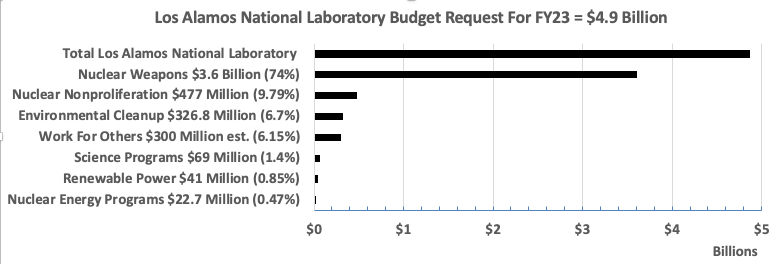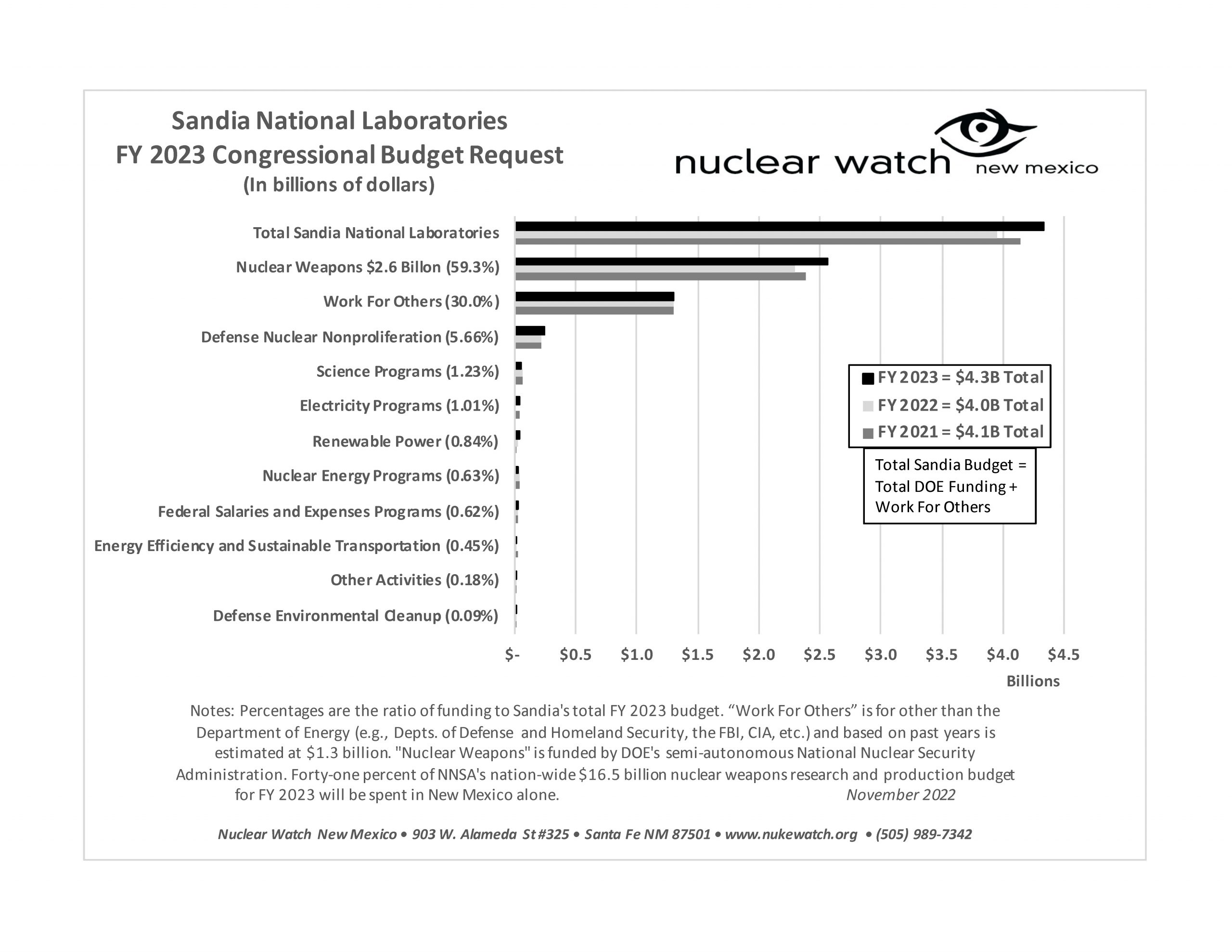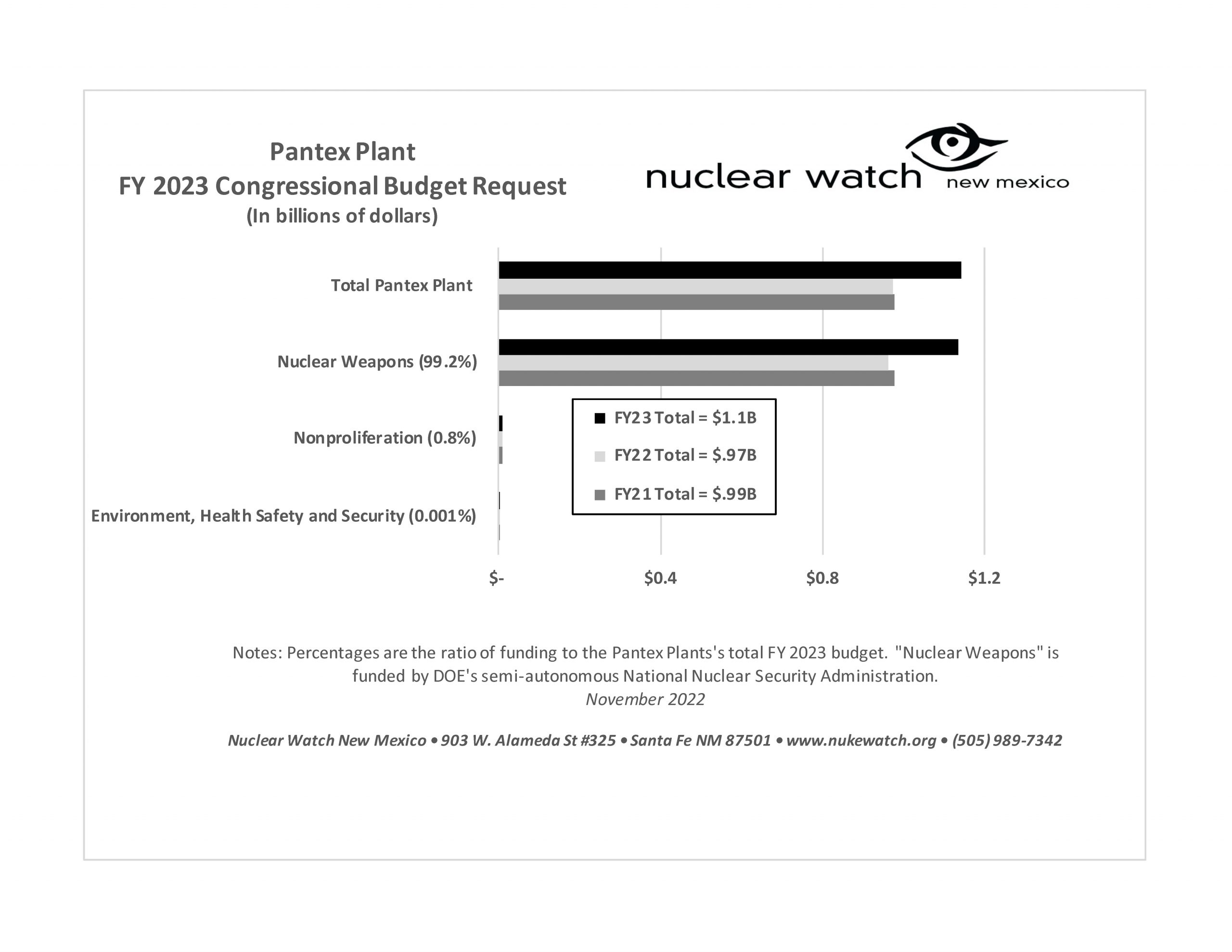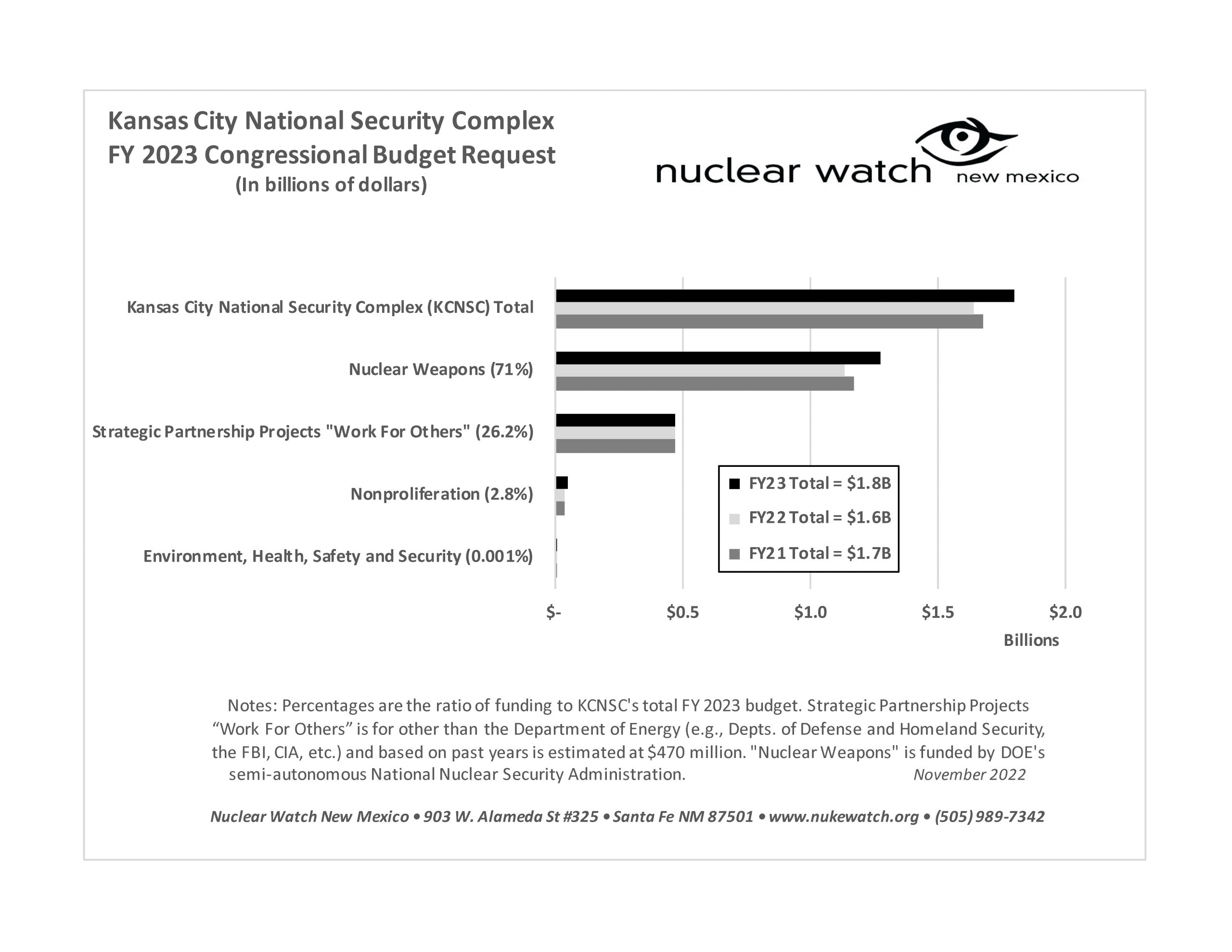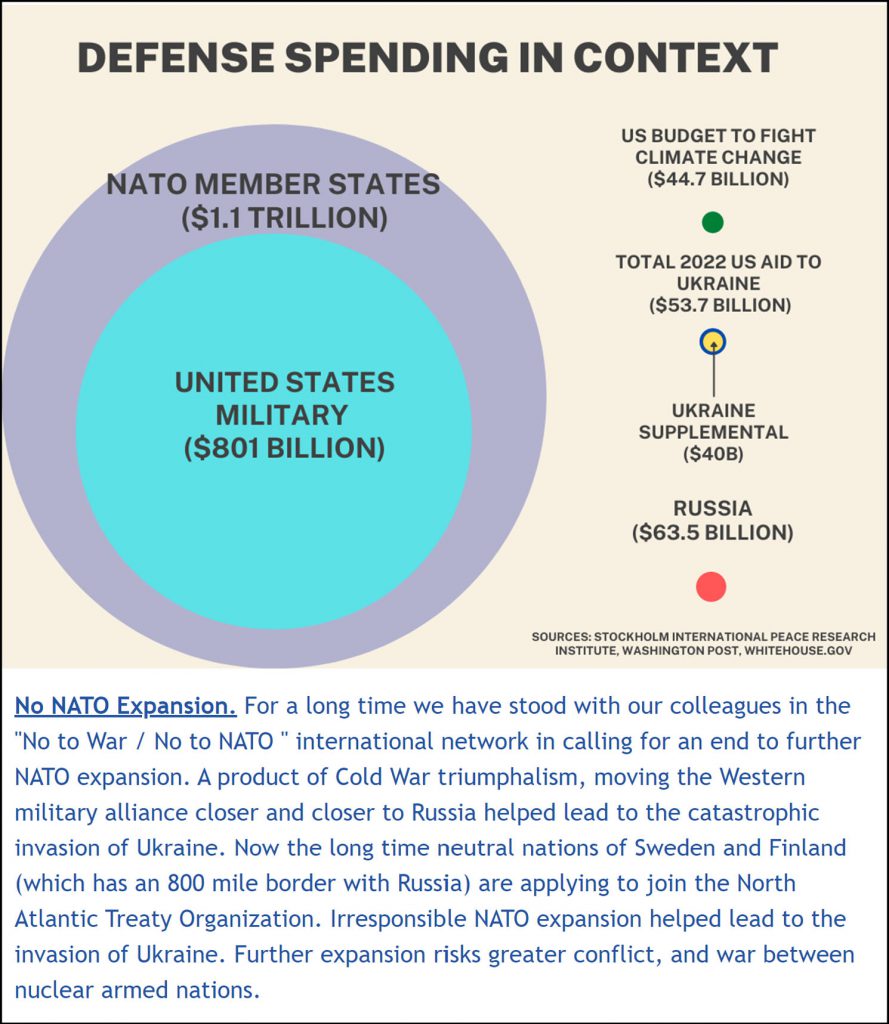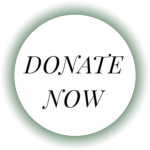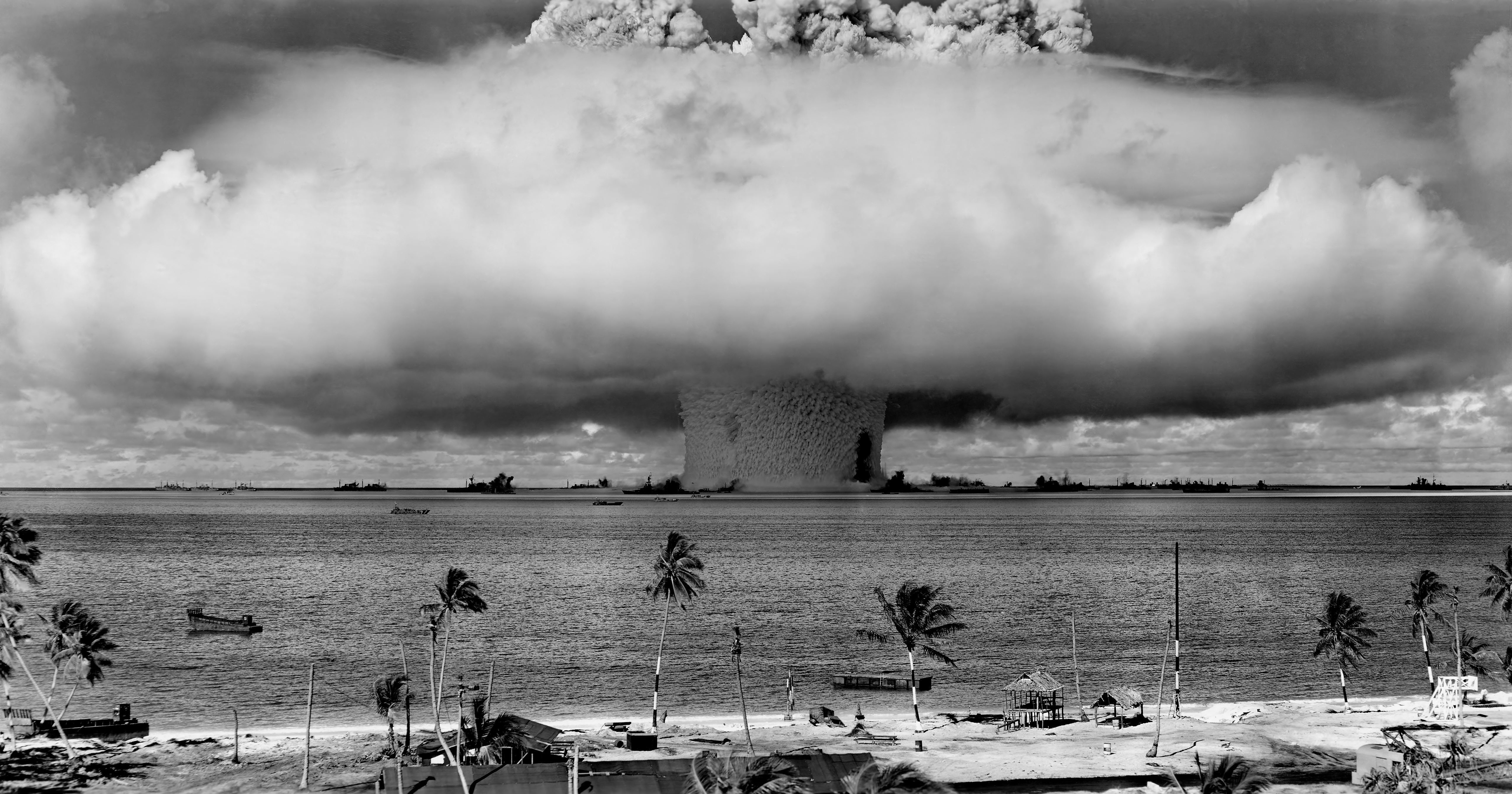QUOTE OF THE WEEK
Nothing Found
It seems we can’t find what you’re looking for. Perhaps searching can help.
LANL’s Central Mission: Los Alamos Lab officials have recently claimed that LANL has moved away from primarily nuclear weapons to “national security”, but what truly remains as the Labs central mission? Here’s the answer from one of its own documents:
LANL’s “Central Mission”- Presented at: RPI Nuclear Data 2011 Symposium for Criticality Safety and Reactor Applications (PDF) 4/27/11
Banner displaying “Nuclear Weapons Are Now Illegal” at the entrance in front of the Los Alamos National Lab to celebrate the Entry Into Force of the Nuclear Weapon Ban Treaty on January 22, 2021
Nothing Found
It seems we can’t find what you’re looking for. Perhaps searching can help.
Follow the Money!
Map of “Nuclear New Mexico”
Nuclear Watch Interactive Map – U.S. Nuclear Weapons Complex
In 1985, US President Ronald Reagan and and Russian President Mikhail Gorbachev declared that “a nuclear war cannot be won and must never be fought.”

Waste Lands: America’s Forgotten Nuclear Legacy
The Wall St. Journal has compiled a searchable database of contaminated sites across the US. (view)
Related WSJ report: https://www.wsj.com
2022 BLOG POSTS
Nothing Found
It seems we can’t find what you’re looking for. Perhaps searching can help.
New & Updated
International Campaign to Abolish Nuclear Weapons Wins Nobel Peace Prize- NukeWatch Calls on New Mexico Politicians and Santa Fe Archbishop To Support Drive Towards Abolition
Santa Fe, NM.
Nuclear Watch New Mexico strongly applauds the awarding of the Nobel Peace Prize to the International Campaign to Abolish Nuclear Weapons (disclosure: NukeWatch is one of ICAN’s ~400 member groups around the world). This award is especially apt because the peoples of the world are now living at the highest risk for nuclear war since the middle 1980’s, when during President Reagan’s military buildup the Soviet Union became convinced that the United States might launch a pre-emptive nuclear first strike. Today, we not only have Trump’s threats to “totally destroy” North Korea and Kim Jong-un’s counter threats, but also renewed Russian fears of a US preemptive nuclear attack… Generally unknown to the American taxpayer, our government has quietly tripled the lethality of the US nuclear weapons stockpile…”
Expanded Plutonium Pit Production at LANL Will Not Result in Significant Positive Effect On Job Creation and the Regional Economy
The National Nuclear Security Administration’s own documents have explicitly stated that expanded pit production would have no significant positive effect on job creation and the regional economy of northern New Mexico. Nuclear Watch argues that expanded plutonium pit production could actually have negative effect if it blocks other economic alternatives such as comprehensive cleanup, which could be the real job producer.Continue reading
Talking Points: The 2016 LANL Cleanup Consent Order Should Be Rescinded
Why rescind the 2016 Consent Order?
- In June 2016 the New Mexico Environment Department (NMED), the Department of Energy (DOE) and Los Alamos National Security, LLC (LANS) signed a revised Consent Order governing cleanup at the Los Alamos National Laboratory (LANL). The new Consent Order is a big step backwards in achieving comprehensive, genuine cleanup at the Lab.
- NMED should have kept the original, enforceable 2005 Consent Order that it fought so hard for under the Richardson Administration, modified as needed for the cleanup schedule and final compliance date.
- Under Gov. Martinez, the revised 2016 Consent Order was a giveaway by NMED to DOE and the Lab, surrendering the strong enforceability of the old Consent Order. As documented below, it is clearly the reverse of the 2005 Consent Order, whose underlying goal was to make DOE and LANL get more money from Congress for accelerated cleanup.
The 2016 Consent Order was negotiated to allow DOE’s budget to drive cleanup, not what is needed to permanently protect our water.
- As late as 1996 LANL was claiming that groundwater contamination from its operations was impossible, even going so far as to request a waiver from NMED from having to monitor for contamination to begin with (which fortunately NMED denied).
- Since then, extensive groundwater contamination from chromium, perchlorates, high explosives and VOCs has been documented.
- As a harbinger of more to come, plutonium has been detected up to 240 feet below the surface of Area G, the Lab’s largest waste dump. See https://nukewatch.org/importantdocs/resources/AGCME-Plate_B-3_radionuclides_subsurface.pdf
LANL plans to “cap and cover” some 200,000 cubic meters of toxic and radioactive wastes at Area G, creating a permanent nuclear waste dump in unlined pits and shafts.
- Despite the threat to precious water resources, the revised 2016 Consent Order allows DOE to determine cleanup priorities based on its anticipated budget, which is the reverse of the original Consent Order.
- The new Consent Order allows LANL and DOE to get out of future cleanup by simply claiming that it’s too expensive or impractical to clean up. (See CO quotes below.)
- Shortly after the 2016 Consent Order went into effect, DOE took advantage of it by estimating a lifetime budget that projected a top range of $3.8 billion to clean up the Lab, while delaying completion to 2040. That works out to only around $150 million per year, when NMED is already on record that $250 million per year is needed. DOE is planning “cleanup” on the cheap.
- Worst of all, DOE claimed that only 5,000 cubic meters of mixed radioactive wastes need to be cleaned up, willfully ignoring the estimated 200,000 cubic meters in Area G alone. See https://nukewatch.org/importantdocs/resources/LBC-Summary-Aug-2016.pdf, p. 3.
Whose interests were represented in the 2016 Consent Order? Not New Mexico’s!
- Shortly after the 2016 Consent Order went into effect, NMED Secretary Ryan Flynn displayed his true environmental colors by resigning to become the Executive Director of the New Mexico Oil and Gas Association. The Association’s main purpose is to lobby on behalf of the oil and gas industry against environmental regulations.
- Before joining NMED, Mr. Flynn worked for a law firm that advertises that “Our representation of oil and gas producers, mid-stream entities, and natural gas pipelines has been a mainstay of Modrall Sperling’s natural resources practice since the early days of the firm.” Modrall Sperling has also defended LANL or LANS (LANL’s managing contractor) against environment regulations and labor complaints.
- In January 2017 Kathryn Roberts, the head of NMED’s Resource Protection Division and lead Consent Order negotiator, announced that she was leaving to work as a public communications specialist for Longenecker and Associates, a DOE contractor. Prior to working at NMED, Ms. Roberts worked at LANL for four years as Group Leader for Regulatory Support and Performance.
- At Longenecker Ms. Roberts joined Christine Gelles, its Corporate Vice President and Chief Strategy Officer. They know each other well, as Ms. Gelles was the former interim manager of the new DOE Environmental Management field office at the Los Alamos Lab. A Longenecker resume´ notes that Gelles “Led planning and initial regulatory interactions with New Mexico Environment Department negotiation of Los Alamos Consent Order.” She also led initial development of the LANL lifetime budget that will cheat New Mexico out of needed increased cleanup funding. See
- During the 2016 Consent Order negotiations, Ms. Roberts was one of Gelles’ main counterparts on the other side of the table as head of NMED’s Resource Protection Division. Now Gelles is one of her superiors at Longenecker, when the DOE contractor could possibly bid in the future on LANL cleanup.
- Section II.A of the 2016 Consent Order allowed the Lab to “settle any outstanding violations of the 2005 Consent Order.” Existing violations were then waived.
- NMED pre-emptively surrendered its regulatory and enforcement powers, when the state of New Mexico really needed the money!
- New Mexico could have collected more than $300 million in stipulated penalties had NMED vigorously enforced the 2005 Consent Order. At the time, New Mexico was facing a budget crisis with a projected $600 million deficit. In effect, NMED gave half of that deficit away to a polluting nuclear weapons site that has an annual budget of ~$2.4 billion and rising.
The 2005 Consent Order was all about the enforceable schedules.
- The 2005 Consent Order required DOE and LANL to investigate, characterize, and clean up hazardous and mixed radioactive contaminants from 70 years of nuclear weapons research and production.
- It stipulated a detailed compliance schedule that the Lab was required to meet. Ironically, the last milestone, due in December 2015, required a report from LANL on how it successfully cleaned up Area G, its largest waste dump.
Under Gov. Martinez, NMED extensions eviscerated the 2005 Consent Order.
- When NMED Secretary Ryan Flynn announced a draft new Consent Order on March 30, 2016, he publicly claimed that the 2005 Consent Order was not working, hence the need for a new one to replace it.
- Nuclear Watch agrees that the 2005 Consent Order wasn’t working, but that’s because Flynn granted more than 150 compliance milestone extensions at the Lab’s request, effectively eviscerating it. The 2005 Consent Order was working quite well until Gov. Martinez took office.
Some specific provisions in the 2016 Consent Order that put DOE in the drivers seat.
- “The Parties agree that DOE’s project’s plans and tools will be used to identify proposed milestones and targets.” See https://www.env.nm.gov/wp-content/uploads/2015/12/LANL_Consent_Order_FINAL.pdf, p. 28.
- “DOE shall define the use of screening levels and cleanup levels at a site…” Ibid, p. 32.
- “DOE shall update the milestones and targets in Appendix B on an annual basis, accounting for such factors as… changes in anticipated funding levels.” Ibid, p. 29.
- “… [DOE and NMED] shall meet to discuss the appropriation and any necessary revision to the forecast, e.g. DOE did not receive adequate appropriations from Congress…” Ibid, p. 30.
- “If attainment of established cleanup objectives is demonstrated to be technically infeasible, DOE may perform risk-based alternative cleanup objectives…” Ibid, p. 34. DOE can opt out because of “impracticability” or cost of cleanup. Ibid, p. 35.
- Altogether, these put the Department of Energy in the driver’s seat, not the New Mexico Environment Department, and create giant loopholes that threaten comprehensive cleanup at LANL. The 2016 Consent Order and therefore cleanup at LANL will be held hostage to DOE funding, when the Department’s own track record makes clear that its priority is expanded nuclear weapons production paid for in part by cutting cleanup and nonproliferation programs.
All future cleanup does not have cradle to grave enforceable deadlines.
- Under the 2016 Consent Order, all anticipated cleanup projects do not have scheduled, enforceable cleanup deadlines from the beginning to the end of the project. This will encourage a lack of accountability in LANL cleanup programs that are already slow, incomplete, and wasteful of taxpayers’ dollars.
- The 2016 Consent Order eliminates all the final deadlines for completing cleanup under the 2005 Consent Order, and replaces them with an open-ended and vague scheduling process, with highly limited enforcement opportunities.
- The 2005 Consent Order (Section XII) established dozens of detailed deadlines for the completion of corrective action tasks, including completion of investigations at individual sites, installation of groundwater monitoring wells, submittal of groundwater monitoring reports, evaluation of remedial alternatives for individual sites, and completion of final remedies. These deadlines were truly enforceable under Section III.G.
- The 2016 Consent Order abandons the 2005 Consent Order provisions and replaces them with a so-called “Campaign Approach” under Section VIII. Under Section VIII.A.3, it would be up to the DOE, not the regulator (i.e., NMED) to select the timing and scope of each “campaign.”
- “Campaigns” have enforceable cleanup deadlines for only the work scheduled for the current year, when cleanup takes many years. These campaigns are to be negotiated each year between NMED and DOE with no public participation and opportunity to comment on the schedule. To add insult to injury, the annual schedule is determined by funding at DOE’s discretion, rather than the schedule driving the funding, which was the fundamental driver of the 2005 Consent Order.
- All cleanup projects should have mandatory completion dates scheduled from the beginning, and must be fully enforceable. The 2016 Consent Order miserably fails that test.
The opportunity for a public hearing was not provided.
- Any extension of a final compliance date (which was December 6, 2015) under the 2005 Consent Order should have been implemented only after the opportunity for public comment and a public hearing, including formal testimony and cross-examination of witnesses.
- The Environment Department was legally required to follow these public participation requirements that were explicitly incorporated into the 2005 Consent Order, but did not.
Public participation provisions in the 2005 Consent Order were not incorporated into the 2016 Consent Order.
- The 2016 Consent Order explicitly limits public participation requirements that were incorporated into the 2005 Consent Order.
- All notices, milestones, targets, annual negotiations, and modifications should have had public review and comment and the opportunity for a public hearing, but did not.
Comprehensive cleanup at LANL would be a win-win for northern New Mexicans, permanently protecting the environment while providing hundreds of high paying jobs.
- When DOE wants to do something, it lowballs the cost. When DOE doesn’t want to do something, it highballs the cost. LANL has estimated that comprehensive cleanup of Area G would cost $29 billion. Using actual costs of cleaning up smaller dumps, Nuclear Watch has extrapolated that cleanup of Area G would cost $7 to 8 billion. See https://nukewatch.org/facts/nwd/Area_G_Comparison_Costs-11-14-12.pdf
- But of that $29 billion, DOE estimated that labor costs would be $13 billion. Applying that 45% proportion to Nuclear Watch’s estimate, that would be around $3.5 billion in jobs, jobs that northern New Mexico sorely needs.
- In contrast, the government’s own environmental impact statement for a $6.5 billion nuclear weapons facility for expanded plutonium pit production stated that it would not produce a single new lab job, because it would merely relocate existing lab jobs.
- Comprehensive cleanup at LANL would be a real job producer!
Chromium Groundwater Contamination at Los Alamos Lab Far Greater Than Previously Expected; LANL’s Treatment Plan Must Be Drastically Changed
The Los Alamos National Laboratory (LANL) has detected far more hexavalent chromium (Cr) contamination than previously estimated in the “sole source” regional groundwater aquifer that serves Los Alamos, Santa Fe and the Española Basin. Sampling in July from a new well meant to inject treated groundwater back into the aquifer detected chromium contamination five times greater than the New Mexico groundwater standard of 50 micrograms per liter (ug/L).
Hexavalent chromium is a known carcinogen, and is the culprit in many illnesses as depicted in the well-known film Erin Brockovich. A “sole source aquifer” is a designation given by the Environmental Protection Agency when an aquifer supplies at least 50 percent of the drinking water for its service area and there are no reasonably available alternative drinking water sources should the aquifer become contaminated. Nuclear Watch discovered the alarming data in obscure entries in the Lab’s contamination database IntellusNM (http://intellusnm.com).
The location of the particular well, Chromium Injection Well 6 (CrIN-6), was chosen because LANL thought that it would be on the edge of the chromium groundwater plume where detection samples would be below the New Mexico standard of 50 ug/L, or in other words on the boundary of what legally requires treatment. Given this new information, if this new well is used to inject treated water, it will help push the contamination beyond Lab boundaries instead of blocking it. The thickness of the chromium plume at this location is not exactly known, but elsewhere it contaminates approximately the top 80 feet of the groundwater aquifer.
LANL’s “Chromium Plume Interim Measures Plan”, approved by the New Mexico Environment Department (NMED), is designed to remove chromium contaminated water from the center of the plume through extraction wells, treat it so it meets the state’s ground water standard, and inject the treated water into the leading edge of the plume in an attempt to slow or halt the plume migration.
CrIN-6 is currently the last proposed injection well, while injection wells 1 through 5 are already active. The new data indicates that the leading edge of the plume passed CrIN-6’s location some time ago. Injecting treated water into it now will only serve to push the plume farther east toward San Ildefonso Pueblo and the Buckman Wells that the City of Santa Fe relies on for a third of its drinking water.
The new data suggest there will have to be will have to be a complete re-thinking of chromium groundwater treatment by LANL and NMED, with more wells needed to both accurately find the true boundary of the chromium plume and eventual treatment. This inevitably means that remediation will take longer and cost more, when at the same time NMED weakened its own regulatory authority through a revised Consent Order governing cleanup that it agreed to with the Department of Energy last year (for more, see background below).
Jay Coghlan, Nuclear Watch Director, commented, “Timely budgets for additional urgently needed cleanup work at Los Alamos are far from being a given. The 2016 Consent Order that NMED and DOE negotiated both weakened and delayed cleanup at LANL, and allows DOE to get out of cleanup by simply claiming that it is too expensive or difficult. But we demand that DOE find additional funding to immediately address this threat to New Mexico’s precious water resources, without robbing other badly needed cleanup projects.” In contrast, funding for the Lab’s nuclear weapons that caused the contamination to begin with continues to grow.
NukeWatch Operations Director, Scott Kovac stated, “It is easy for data to get buried and never see the light of day in the Lab’s contamination database. LANL should proactively keep the public continuously informed of important new developments. NMED and LANL must modify and expand the chromium groundwater treatment plan to meet this growing threat. The new well must not be used for injection, and instead treated water should be injected in front of the contaminant source to help permanently flush it out, instead of behind it which will push the contamination offsite.”
# # #
Background
Chart of samples data from Intellus NM compiled by Nuclear Watch. To locate data, go to http://intellusnm.com and search by Location ID.
| Field Sample ID | Location ID | Sample Date | Parameter Name | Report Result | Report Units | Sample Time |
| CrIN6-17-142149 | CrIN-6 | 07-16-2017 | Chromium | 247.24 | ug/L | 19:00 |
| CrIN6-17-142150 | CrIN-6 | 07-16-2017 | Chromium | 249.69 | ug/L | 23:00 |
| CrIN6-17-142148 | CrIN-6 | 07-17-2017 | Chromium | 262.07 | ug/L | 15:00 |
| CrIN6-17-142151 | CrIN-6 | 07-17-2017 | Chromium | 252.07 | ug/L | 03:00 |
| CrIN6-17-142152 | CrIN-6 | 07-17-2017 | Chromium | 260.22 | ug/L | 11:00 |
| CrIN6-17-142154 | CrIN-6 | 07-17-2017 | Chromium | 257.65 | ug/L | 07:00 |
| CrIN6-17-142163 | CrIN-6 | 07-17-2017 | Chromium | 259 | ug/L | 15:00 |
Chromium was released into the head of Sandia Canyon until 1972.
- Potassium dichromate was used in cooling towers as a corrosion inhibitor at a Laboratory power plant
- Up to 72,000 kg was released from 1956-72 in hexavalent form [Cr(VI)]
Discovered in 2004
- A Cr plume is in the regional aquifer at 900–1,000 feet below the canyon bottom at deepest, which places the Cr into the top of the aquifer
- Size was estimated at approximately 1 mile x 1/2 mile x <50 feet thick
- Plume edge is approximately 1?2 mile from the closest drinking water well
For how the 2016 Consent Order has weakened NMED’s regulatory authority, see https://nukewatch.org/facts/nwd/Consent-Order-should-be-rescinded-9-10-17.pdf
Expanded Plutonium Pit Production at LANL Will Not Result in Significant Positive Effect On Job Creation and the Regional Economy
Abstract: Expanded production of plutonium pits, the fissile cores of modern thermonuclear weapons, is cynically being justified as a source of job creation. Precise data on employment in plutonium pit production at the Los Alamos National Laboratory (LANL) and the number of additional jobs if expanded is not publicly available to our knowledge. However, the National Nuclear Security Administration’s own documents quoted below explicitly state that expanded pit production would not have any significant positive effect on job creation and the regional economy of northern New Mexico. Further, Nuclear Watch argues that expanded plutonium pit production could actually have negative effect if expanded pit production blocks other economic alternatives such as comprehensive cleanup, which could be the real job producer. Moreover, given LANL’s poor safety and environmental record, expanded plutonium pit production could have a seriously negative economic effect on northern New Mexico in the event of any major accidents or additional contamination.
Final Supplemental Environmental Impact Statement for the Nuclear Facility Portion of the Chemistry and Metallurgy Research Building Replacement Project at Los Alamos National Laboratory, Los Alamos, New Mexico
https://energy.gov/nepa/eis-0350-s1-supplemental-environmental-impact-statement-nuclear-facility-portion-chemistry-and
Bolded emphasis added
Note: The CMRR-Nuclear Facility was the up to $6.5 billion dollar plutonium facility NNSA proposed to build at LANL in direct support of expanded plutonium pit production. The Obama Administration cancelled it in 2012 after costs rose so high. Nevertheless, the 2011 CMRR-Nuclear Facility supplemental environmental impact statement remains the most relevant source of publically available socioeconomic information concerning expanded plutonium pit production that we know of.
Volume 1, p. 2-43, Socioeconomics
…
Under the Modified CMRR-NF Alternative, an increase in construction-related jobs and businesses in the region surrounding LANL is also expected. Construction employment would be needed over the course of a 9-year construction period under either the Deep or Shallow Excavation Option. Construction employment under either option is projected to peak at about 790 workers, which is expected to generate about 450 indirect jobs in the region. Operation of the Modified CMRR-NF and RLUOB would involve about 550 workers at LANL, with additional workers using the facility on a part-time basis. The personnel working in the Modified CMRR-NF and RLUOB, when fully operational, would relocate from other buildings at LANL, including the existing CMR Building, so an increase in the overall number of workers at LANL is not expected.
Note: The first phase of the Chemistry and Metallurgy Research Replacement Project, the Radiological Laboratory Utility and Office Building (RLUOB), is already built. It is now being retrofitted to handle up to 400 grams of plutonium-239 equivalent instead of the original 8.4 grams. This will greatly increase its special nuclear materials analytical chemistry and materials characterization capabilities in direct support of expanded plutonium pit production.
Under the Continued Use of CMR Building Alternative, about 210 employees would continue to work in the CMR Building until safety concerns force additional reductions in facility operations. In addition, about 140 employees would be employed at RLUOB. A total of about 350 personnel would have their offices relocated to RLUOB. The personnel working in the CMR Building and RLUOB, when fully operational, would not result in an increase in the overall number of workers at LANL.
Pg. 4-12
4.2.9 Socioeconomics
Construction Impacts—Construction of new buildings at TA-55 to house CMR activities would require a peak construction employment level of 300 workers. This level of employment would generate about 852 indirect jobs in the region around LANL. The potential total employment increase of 1,152 direct and indirect jobs represents an approximate 1.3 percent increase in the workforce and would occur over the proposed construction period. This small increase would have little or no noticeable impact on the socioeconomic conditions of the region of influence (ROI).
Operations Impacts—CMRR Facility operations would require a workforce of approximately 550 workers. As evaluated in the CMRR EIS, this would be an increase of about 340 workers over currently restricted CMR Building operational requirements. Nevertheless, the increase in the number of workers in support of expanded CMRR Facility operations would have little or no noticeable impact on socioeconomic conditions in the LANL ROI (region of influence). New LANL employees hired to support the CMRR Facility would compose a small fraction of the LANL workforce and an even smaller fraction of the regional workforce.
4.3.9 Socioeconomics
Construction Impacts – Deep Excavation Option—Construction of the Modified CMRR-NF under the Deep Excavation Option would require a peak construction employment level of about 790 workers (LANL 2011a:Data Call Tables, 002). This level of employment would generate about 450 indirect jobs in the region around LANL. The potential total peak employment of 1,240 direct and indirect jobs represents an increase in the ROI workforce of approximately 0.8 percent. Direct construction employment would average 420 workers annually over this time, approximately half of the estimated peak employment. The average direct construction employment would result in about 240 indirect jobs in the region around LANL. This total of 660 direct and indirect jobs represents an approximate 0.4 percent increase in the ROI workforce. These small increases would have little or no noticeable impact on the socioeconomic conditions of the ROI.
Pg. 4-54
Chapter 4 – Environmental Consequences
Construction Impacts – Shallow Excavation Option—The impacts under the Shallow Excavation Option from construction of the Modified CMRR-NF would be similar to the Deep Excavation Option. The peak employment number of about 790 construction workers would be the same as under the Deep Excavation Option, and the annual average would be 410 workers over the life of the project. The average direct construction employment would result in about 240 indirect jobs in the region around LANL. This total of 650 direct and indirect jobs represents an approximate 0.4 percent increase in the ROI workforce. Therefore, there would be little or no noticeable impact on the socioeconomic conditions of the ROI.
Operations Impacts—Operations at the Modified CMRR-NF and RLUOB would require a workforce of approximately 550 workers, including workers that would come from other locations at LANL to use the Modified CMRR-NF laboratory capabilities. The number of workers in support of Modified CMRR-NF operations would cause no change to socioeconomic conditions in the LANL four-county ROI (region of influence). Workers assigned to the Modified CMRR-NF and RLUOB would be drawn from existing LANL facilities, including the CMR Building. The number of LANL employees supporting the Modified CMRR-NF and RLUOB operations would represent only a small fraction of the LANL workforce (approximately 13,500 in 2010) and an even smaller fraction of the regional workforce (approximately 165,000 in 2010).
Volume 2, p. 2-13: As discussed in this CMRR-NF SEIS, operation of the new CMRR-NF, if built, is not expected to result in any increase in LANL employment. The people expected to work in the new facility would be transferred from other facilities at LANL where CMR-related activities are currently being accomplished (such as the CMR Building).
– End of NNSA quotes –
Note: The CMRR-Nuclear Facility was expected to cost up to $6.5 billion. It’s pathetic that the largest construction project ever in New Mexico (with the exception of the interstate highways) was going to create no new Lab jobs.
Comprehensive cleanup at LANL would be a win-win for northern New Mexicans, permanently protecting the environment while providing hundreds of high paying jobs.
- When DOE wants to do something, it lowballs the cost. When DOE doesn’t want to do something, it highballs the cost. LANL has estimated that comprehensive cleanup of Area G would cost $29 billion. Using actual costs of cleaning up smaller dumps, Nuclear Watch has extrapolated that cleanup of Area G would cost $7 to 8 billion. See https://nukewatch.org/facts/nwd/Area_G_Comparison_Costs-11-14-12.pdf
- But of that $29 billion, DOE estimated that labor costs would be $13 billion. Applying that 45% proportion to Nuclear Watch’s estimate, that would be around $3.5 billion in jobs, jobs that northern New Mexico sorely needs.
- Comprehensive cleanup could be the real job producer. It has the additional advantage of being more conducive to regional economic development in that more locally based contractors could possibly do the cleanup work, instead nuclear weapons work such as expanded plutonium pit production conducted by huge out-of-state defense contractors such as Bechtel and Lockheed Martin.
Chromium Groundwater Contamination at Los Alamos Lab Far Greater Than Previously Expected; LANL’s Treatment Plan Must Be Drastically Changed
Santa Fe, NM.
The Los Alamos National Laboratory (LANL) has detected far more hexavalent chromium (Cr) contamination than previously estimated in the “sole source” regional groundwater aquifer that serves Los Alamos, Santa Fe and the Española Basin. Sampling in July from a new well meant to inject treated groundwater back into the aquifer detected chromium contamination five times greater than the New Mexico groundwater standard of 50 micrograms per liter (ug/L).
Talking Points: The 2016 LANL Cleanup Consent Order Should Be Rescinded
The 2005 LANL Cleanup Consent Order was all about the enforceable schedules. It required DOE and LANL to investigate, characterize, and clean up hazardous and mixed radioactive contaminants from 70 years of nuclear weapons research and production. It stipulated a detailed compliance schedule that the Lab was required to meet…Continue reading
Talking Points: The 2016 LANL Cleanup Consent Order Should Be Rescinded
Why rescind the 2016 Consent Order?
- In June 2016 the New Mexico Environment Department (NMED), the Department of Energy (DOE) and Los Alamos National Security, LLC (LANS) signed a revised Consent Order governing cleanup at the Los Alamos National Laboratory (LANL). The new Consent Order is a big step backward in achieving comprehensive, genuine cleanup at the Lab.
- NMED should have kept the original, enforceable 2005 Consent Order that it fought so hard for under the Richardson Administration, modified as needed for the cleanup schedule and final compliance date.
Defense Nuclear Facilities Safety Board to advocate for nuclear weaponeers?
From our colleague Don Hancock at the Southwest Research and Information Center:
Two members (Roberson and Santos) of the Defense Nuclear Facilities Safety Board (DNFSB) have gone public over an internal dispute about a Memorandum of Agreement between DNFSB and the National Nuclear Security Administration (NNSA) in which DNFSB staff would be detailed to NNSA so that, among other things, they would be “advocating for and defending NNSA’s FY 2018 budget request.” The internal memo is posted at: https://www.dnfsb.gov/sites/default/files/document/12526/Memo%20from%20Roberson%20and%20Santos%2C%20Objection%20to%20Memorandum%20of%20Agreement%20with%20DOE.NNSA%20.pdf
The memo is dated last Friday (August 11) and the detail would start August 21. Not a good sign that DNFSB is, in part, going from overseeing DOE weapons sites to advocating for NNSA’s budget. – End –
Our comment:
“Nuclear Watch New Mexico strongly objects to this attempt by the National Nuclear Security Administration to compromise the Safety Board. DNFSB has played a vital role in protecting the public from dangerous nuclear weapons activities that have been riddled with safety lapses, incompetence, cost overruns and mismanagement. The Safety Board is commissioned by Congress, not NNSA, and we fully expect the New Mexican congressional delegation to protect the Safety Board’s independence and objectivity.”
Nuclear war can be avoided – let’s get it right!
Despite the hyperbole from both Trump and Kim Jong Un, nuclear war can be avoided. This not an argument for complacency, but rather to get it right.
Perhaps the silver lining in the crisis with North Korea can be that that the focused attention of the peoples of the world will rise to demand brakes on nuclear weapons, as it did to great effect in the 1980’s. But now we finally have an international treaty banning nuclear weapons, just like chemical and biological weapons. It won’t be easy, but let’s roll up our sleeves and get the job done!
North Korea’s “not quite” ICBM can’t hit the lower 48 states
Theodore A. Postol, Markus Schiller, Robert Schmucker
From the point of view of North Korean political leadership, the general reaction to the July 4 and July 28 launches could not have been better. The world suddenly believed that the North Koreans had an ICBM that could reach the West Coast of the United States and beyond. But calculations we have made—based on detailed study of the type and size of the rocket motors used, the flight times of the stages of the rockets, the propellant likely used, and other technical factors—indicate that these rockets actually carried very small payloads that were nowhere near the weight of a nuclear warhead of the type North Korea could have, or could eventually have. These small payloads allowed the rockets to be lofted to far higher altitudes than they would have if loaded with a much-heavier warhead, creating the impression that North Korea was on the cusp of achieving ICBM capability.
In reality, the North Korean rocket fired twice last month—the Hwasong-14—is a “sub-level” ICBM that will not be able to deliver nuclear warheads to the continental United States. Our analysis shows that the current variant of the Hwasong-14 may not even be capable of delivering a first-generation nuclear warhead to Anchorage, Alaska, although such a possibility cannot be categorically ruled out. But even if North Korea is now capable of fabricating a relatively light-weight, “miniaturized” atomic bomb that can survive the extreme reentry environments of long-range rocket delivery, it will, with certainty, not be able to deliver such an atomic bomb to the lower 48 states of the United States with the rocket tested on July 3 and July 28.
….
We emphasize at this point that advances in rocketry demonstrated by North Korea in the Hwasong-14 are significant, and although the Hwasong-14 is not an immediate threat to the continental United States, variants that are almost certainly now under development, but probably years away from completion, will eventually become missiles with sufficient payloads to deliver atomic bombs to the continental United States.
…
General conclusions—for now. Our general conclusions from intensive study of a wide variety of data relating to the two rockets that North Korea launched in July:
- The Hwasong-14 does not currently constitute a nuclear threat to the lower 48 states of the United States.
- The flight tests on July 4 and 28 were a carefully choreographed deception by North Korea to create a false impression that the Hwasong-14 is a near-ICBM that poses a nuclear threat to the continental US.
- The Hwasong-14 tested on July 4 and 28 may not even be able to deliver a North Korean atomic bomb to Anchorage, Alaska.
- Although it is clear that North Korea is not capable of manufacturing sophisticated rocket components, their skill and ingenuity in using Soviet rocket motor components has grown very substantially. This is not good news for the long run.
It is time for the United States to get serious about diplomacy and appropriate defensive preparations (see sidebar, “Comments on the developing situation with North Korea”) to constructively support those diplomatic efforts.
NMED claims revised Consent Order is a stronger enforcement tool. Not so!
Rebecca Moss at the New Mexican has another hard charging article on safety lapses at the Los Alamos Lab. See “Lab might have known dangerous waste was unmarked” at www.santafenewmexican.com/news/local_news/lab-might-have-known-dangerous-waste-was-unmarked/article_19d37b31-219a-5620-954c-a62fa9620d2a.html
If the New Mexico Environment Department is claiming, as this article reports, that its revised Consent Order governing cleanup at the Los Alamos National Laboratory (LANL) is a stronger enforcement tool than the original 2005 Consent Order, then it is being highly disingenuous (to put it politely).
Interested citizens should judge for themselves. The 2016 revised Consent Order is available at https://web.archive.org/web/20170615022416/http://www.lanl.gov/environment/protection/compliance/order-on-consent.php
The revised Consent Order was a giveaway by NMED to the Department of Energy and the Lab, surrendering the strong enforceability of the old Consent Order. It is clearly the opposite of the old Consent Order, whose underlying intent was to make DOE and LANL get more money from Congress for accelerated cleanup.
The new Consent Order allows LANL and DOE to get out of future cleanup by simply claiming that it’s too expensive or impractical to clean up. Not long after the revised Consent Order went into effect, DOE took advantage by estimating a lifetime budget that projected a top range of $3.8 billion to clean up the Lab by 2040. That works out to only around $150 million per year, when NMED is already on record that $250 million per year is needed. Most egregious of all, DOE claimed that only 5,000 cubic meters of wastes needed to be cleaned up, purposively misleading the public and politicians by willfully ignoring the ~200,000 cubic meters of radioactive and toxic wastes known to be buried in LANL’s biggest dump alone.
Some of the highlights (or perhaps better put as lowlights) of the revised Consent Order are:
- “The Parties agree that DOE’s project’s plans and tools will be used to identify proposed milestones and targets.” P. 28. “DOE shall define the use of screening levels and cleanup levels at a site…” P. 32. This puts the Department of Energy in the driver’s seat, not the New Mexico Environment Department
- “DOE shall update the milestones and targets in Appendix B on an annual basis, accounting for such factors as… changes in anticipated funding levels.” P. 29. Therefore the new Consent Order is held hostage to DOE’s budget.“… [DOE and NMED] shall meet to discuss the appropriation and any necessary revision to the forecast, e.g. DOE did not receive adequate appropriations from Congress…” P. 30. Again, the new Consent Order and therefore cleanup at LANL will be held hostage to DOE funding, when DOE’s own track record makes clear that its priority is expanded nuclear weapons production paid for in part by cutting cleanup and nonproliferation programs.
- “If attainment of established cleanup objectives is demonstrated to be technically infeasible, DOE may perform risk-based alternative cleanup objectives…” P. 34. DOE can opt out because of “impracticability” or cost of cleanup. P. 35. This creates giant loopholes that threaten comprehensive cleanup at LANL.
Given all this, how can NMED claim with a straight face that the 2016 revised Consent Order is a stronger enforcement tool? This is just more of the Martinez administration coddling the nuclear weapons industry in New Mexico. Indeed, NMED had the gall to give LANL more than 150 extensions to the original Consent Order, and then turned around and claimed the Consent Order was not working and replaced it with a toothless tiger. Furthermore, and this is telling, the main Consent Order negotiator for NMED left shortly after it was signed to go work for a DOE contractor!
New Mexicans should demand comprehensive, enforceable cleanup at the Lab, which would be a real win-win, permanently protecting our precious water resources while providing hundreds of high paying jobs.
Lawsuit aims to halt Uranium Processing Facility construction to review earthquake risks
Lawsuit aims to halt Uranium Processing Facility construction to review earthquake risks
Brittany Crocker, USA TODAY NETWORK – Tennessee Published 11:00 a.m. ET July 28, 2017
Prior to this lawsuit, a federal safety board also raised concerns over seismic risks at the UPF and at two older buildings Y-12 plans to continue using.
A lawsuit filed last week against the Department of Energy and National Nuclear Security Administration (NNSA) alleges the government agencies ignored new information about seismic risks during a second environmental review on Y-12 National Security Complex’s Uranium Processing Facility.
The Oak Ridge Environmental Peace Alliance filed the lawsuit in Washington with Nuclear Watch New Mexico and the Natural Resources Defense Council to stop the building’s construction until another environmental review is completed.
The plaintiff organizations asserted revised plans for the Uranium Processing Facility are significantly different from those the NNSA analyzed in 2011. They said NNSA’s supplementary environmental review of the revised plans only covered earthquake risks at the new facility, and not the two legacy buildings Y-12 plans to continue using.
Annual Sackcloth and Ashes Hiroshima Day Peace Vigil at Los Alamos, NM
Annual Sackcloth and Ashes Hiroshima Day Peace Vigil at Los Alamos, NM
Saturday, August 5th, 2017, people will gather at 2:00 p.m. at Ashley Pond Park in Los Alamos, NM for the annual sackcloth and ashes peace vigil to commemorate Hiroshima Day. There will be a quiet walk, then sitting in sackcloth and ashes for 30 minutes, then returning to the park, where friends will reflect together on the current UN movement to outlaw nuclear weapons, with Rev. John Dear and Jay Coghlan of Nukewatch. Bring water, an umbrella and a peace sign.
Every year the Pax Christi NM sponsors this peace vigil commemorating the 1945 bombing of Hiroshima and Nagasaki. “Symbols are very powerful. They bring it all home,” says Father John Dear of Pax Christi New Mexico, the state chapter of an international Catholic peace movement.
Folks slip on sack cloths and carry bags of ashes to depict penitence and conversion to nonviolence, as portrayed in a story from the Book of Jonah in the Bible.
“Jonah used sack cloths and ashes in Nineveh. Two hundred years ago in
Boston, they used tea. Mahatma Gandhi used salt,” Dear says. “With this
symbol, we reclaim an ancient biblical image to show our political and
spiritual opposition to nuclear weapons and the work of Los Alamos.”
Los Alamos Nuclear Weapons Activities Reaches 70% Of Annual Budget
Make no doubt about it, Los Alamos National Laboratory is a nuclear weapons research, development, and production facility. In this year’s FY18 Congressional Budget Request:
70% of the Lab’s budget is Nuclear Weapons Activities
11% is for Nuclear Nonproliferation
10% for ‘Work For Others’
8% Cleanup
1% Science
.4% Nuclear Energy
.2% Renewables
Los Alamos National LaboratoryFY 2018 Congressional Budget Request
(In billions of dollars)
This chart and the FY18 LANL Lab tables to back it up are here
ACTION ALERTS
Nothing Found
It seems we can’t find what you’re looking for. Perhaps searching can help.
Nothing Found
It seems we can’t find what you’re looking for. Perhaps searching can help.
Interfaith Panel Discussion on Nuclear Disarmament - August 9
Nothing Found
It seems we can’t find what you’re looking for. Perhaps searching can help.
New Nuclear Media
Nothing Found
It seems we can’t find what you’re looking for. Perhaps searching can help.




